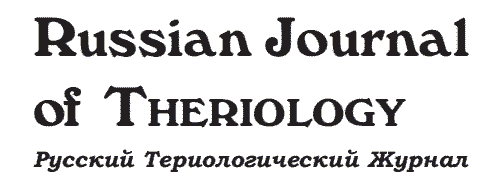|
Table of Contents: Volume 4 (2) 2005 (published 29 May 2006)
Towards the taxonomy of the Russian Murina (Vespertilionidae, Chiroptera)
Kruskop S.V.
P. 91-99
Specimens of the tube-nosed bats genus Murina, deposed in scientific collections of Moscow, Saint-Petersburg and Geneva were examined. Certain differences, mostly based on cranial measurements, were found between larger tube-nosed bats from Siberia and Far East, which give possibility to assign a subspecies rank to these forms. Valid name for the tube-nosed bats from Far East will be ognevi Bianchi, 1916, and for Siberian — sibirica Kastschenko, 1905. As the type of sibirica is absent in the residence mentioned in the original description and was not referred in scientific literature since the Kastschenko’s publication, its neotype is designated here. Larger tube-nosed bats from Siberia and Far East are suggested to be treated as subspecies of Murina hilgendorfi; however the final elucidation of their relationships needs usage of the molecular analysis data. Lesser tube-nosed bats, Murina ussuriensis, are also represented in the Russian territory by the two forms. Bats from Sakhalin differ from mainland specimens and are describing here as a distinct subspecies. However interrelations between this form and lesser tube-nosed bats from Japan, as well as status of different Japanese populations, need further clarification.Details Download PDF
| Cranial and skeletal growth patterns in red foxes (Vulpes vulpes L., 1758)
Englund J.
P. 101-108
Different year-classes of red foxes (Vulpes vulpes) grow to the same mean size during their first autumn of life in areas with a good food supply. Most parts of the cranium, mandible and long bones stop growing during the September-November period in yearlings. The zygomatic width is an exception and continues to grow throughout the winter. Several parts of the cranium and mandible continue to increase for many years.Details Download PDF
| On a taxonomic position of the weasel (Carnivora, Mustela) from the Cheju Island (South Korea)
Abramov A.V.
P. 109-113
The weasel from Cheju Island (formerly — Quelpart Island), which is situated in Korean Strait south of the coast of South Korea, was described as a separate species Lutreola quelpartis Thomas, 1908. The type specimens of Lutreola quelpartis were re-examined and compared with the Japanese weasel Mustela itatsi and the Siberian weasel Mustela sibirica from Korea, Japan, Siberia and China. The analysis of cranial and external characters has revealed that L. quelpartis is to be treated as a subspecies of Mustela sibirica.Details Download PDF
| Analysis of wild boar (Sus scrofa L., 1758) distribution in Northeast of European Russia: A quantitative approach
Markov N.I., Neifeld N.D., McDonald L.L.
P. 115-122
Analysis of a species’ distribution pattern in the marginal part of its geographic range is usually performed on a qualitative level. At the same time, quantitative estimation of area of occupancy could be of great importance for distinguishing the sites inhabited by the species from those where it is “occasionally” found. For large mammals in areas of current or recent expansion an analysis of the distribution patterns is especially complicated by high mobility of the animals, lack of data about habitat preferences and, consequently, the impossibility of using the assumptions of “closed-population models” for estimating area of occupancy. In this study we report a retrospective quantitative analysis of wild boar distribution in one of the areas of European Northeast Russia based on records of occasional detections for the period 1984–1999. Indices of “minimum site occupancy” and “constancy of species’ presence” (the proportion of years, when the species has been recorded within the study area) were used for estimation of species “extent of presence” for the whole study area and distinct parts of it. The wild boar is “vagrant” or not present in most areas situated close to the Ural Mountains. In the plains areas, the species has at least “visitor” status. Thus, only about 50% of the study area could be treated as part of wild boar geographic range. The quantitative method developed allows estimation of the species’ status within a study area and avoids biases in analysis of resource selection by excluding the territories where it is “occasional” or “vagrant”.Details Download PDF
| Pliocene voles (Pliomys, Arvicolinae, Rodentia) from Odessa Catacombs
Tesakov A.S.
P. 123-135
The primitive arvicolid from the fauna of Odessa Catacombs (terminal Ruscinian, MN15, Early Pliocene) is described as a new species of the genus Pliomys, P. destinatus sp. nov. This form is more advanced than Pliomys kowalskii from Late Ruscinain faunas of Moldova and Ukraine in stronger reduced mimomyian ridge and enamel islet of first lower molar. P. destinatus sp. nov. is supposed to be a direct ancestor of Early Villanyian (MN16, Middle Pliocene) Pliomys jalpugensis from southern Ukraine.Details Download PDF
| Parental care in captive Brandt vole (Lasiopodomys brandti Radde, 1861)
Gromov V.G.
P. 137-145
In 10 male-female pairs observed under laboratory conditions, both parents were found to contribute to the care of young during the whole observation period (21 days from parturition) divided into four rearing periods (stages): days 2–6, 7–11, 12–16 and 17–21, respectively. All pairs exhibited permanent nest cohabitation. Paternal activities included nest construction, food caching, huddling over, brooding and grooming the young. There was slight sex differences in total time spent in the nest, but males spent alone in the nest more time than did females. Total time of pup grooming in females was commonly greater than in males. Besides, frequency of manipulations with bedding and bringing nest material to the nest in females were greater than in males. However, the rate of parental activity of males in pup grooming during 3rd stage as well as in manipulations with bedding during 4th stage was found to be similar to that one of females. Besides, males were more active in parental retrieving than females. In L. brandti the biparental care of young with a high direct paternal contribution seems to be associated with family group mode of life of this species. Parental care of Brandt vole is discussed in comparison with that one of other vole species.Details Download PDF
|
|



